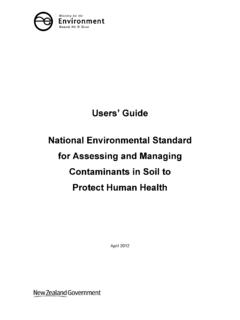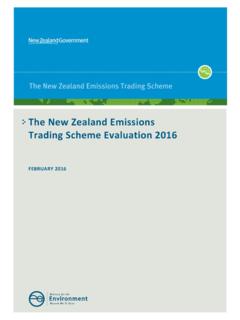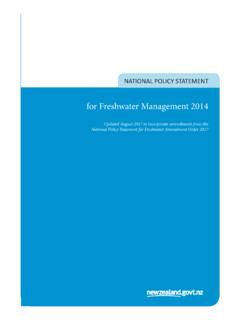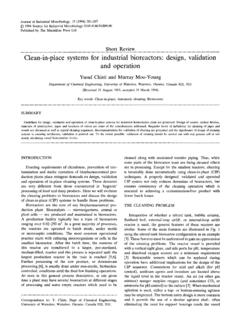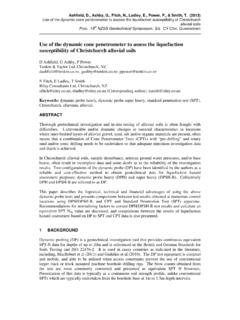Transcription of Soil Conservation Technical Handbook
1 Soil ConservationTechnical HandbookDisclaimerThis Handbook has been prepared by the Ministry for the Environment together with the parties listed in the acknowledgments and published by theNew zealand Association of Resource Management under contract from the Ministry for the Environment. The Handbook represents best currentpractice in the field of soil Conservation in new zealand as at June 2001. The Ministry for the Environment and the new zealand Association of ResourceManagement note however that there may be unacknowledged science work that has been completed or is being undertaken which is pertinent to theHandbook, but which has not been included, mainly due to it not being commonly available as public domain information at the time of publication.
2 Any representation, statement, opinion, or advice expressed in this publication is made in good faith but on the basis that the Ministry for theEnvironment and the new zealand Association of Resource Management are not liable to any person for any damage or loss which has occurred or mayoccur in relation to that person taking or not taking action in respect of any representation, statement, opinion, or advice referred to H HicksTabitha AnthonyPrincipal AuthorsIan CairnsBrian HandysideMurray HarrisNick LambreschtsenNorm NgapoTechnical EditingMary CresswellTechnical Working GroupBob CathcartGarth EylesDex KnowlesContribution AuthorsDoug HicksDon MillerMap Preparation (Appendix II)
3 Andy MandersonLayoutZac GujaZED Communications LtdPublishingThe Ministry for the EnvironmentP O Box 10362 Wellington New ZealandProduction Team for the Soil Conservation HandbookSoil Conservation Technical HandbookJune 2001 ISBN: 0-478-24033-3ME: 404 Soil ConservationTechnical Handbook Cover Photography Slip erosion. Photo: H Cairns. Mount Hikurangi and poplars, Central North Island. Photo: Guy Vickers. A graded bank and space planted trees on an earthflow. Photo: Don Miller. Pole planting. Photo: H zealand has a history of land management that has resulted in soil erosion;silted-up streams rivers and estuaries; algal blooms and dense growth of aquatic weedsfrom nutrient-rich runoff.
4 While considerable progress has been made in achievingmore sustainable land production, significant problems still awareness of soil erosion on hill country in new zealand was polarised bystorm events in the 1930s and 1940s, mostly in the Esk Valley, the Wanganuicatchment, Marlborough and the Waipaoa basin. These and subsequent stormsinitiated soil erosion on a massive scale on the then recently developed pastoral strong northwest winds on the dry plains on the east coasts of the North andSouth Islands have caused tremendous soil loss in the past.
5 It is only after the controlof rabbits and the establishment of wind breaks and vegetative cover on the bare earththat this form of erosion has been bought under control. It was primarily because of the fears that low-lying communities would be inundated ifsoil erosion continued unchecked, that the Soil Conservation and Rivers Control Actwas passed in 1941. This Act established catchment boards and enabled theappropriation of government and local body funds to assist with the construction oferosion control measures and flood protection works.
6 Why are we so interested in sustainable land management and promoting the work inthe Soil Conservation Technical Handbook ? I can list four key reasons. Soil erosion affects downstream communities and the natural environment byincreasing the risk of flooding and causing damage through silt depositions. Our reputation for quality goods from a quality environment depends onsustainable land use practices. Soil erosion is a very visible negative impact ofpastoral land use. That image may affect our clean green image and trade in thefuture.
7 We care about future generations, and that means ensuring ample soil remainsavailable to sustain agricultural production capacity. We want to protect our biodiversity. Our terrestrial biodiversity is dependent on thequality of our soils and its carrying capacity and we want to protect our freshwaterand estuarine aquatic conservators have long been a corner-stone of sustainable land management inNew zealand . Techniques have been developed over the years based on engineeringand scientific principles, as well as some trial and error and time-honoured Kiwiingenuity that adapts techniques to regional the first time in new zealand we have in one place, a comprehensive range ofpractical field-tested soil Conservation practices and techniques.
8 This Handbook hasbeen written by experienced soil conservators drawing on their own and theircolleagues practical experience, under-pinned by the science undertaken on thesubject for the last 50 important area of land management, namely riparian management, is notcovered in depth in this publication. Instead, readers are referred to the MfEpublication Managing Waterways on Farms . This publication is complementary to theHandbook, as they are both based on the same principle of gathering together field-tested techniques and allowing for additional information to be Handbook is a valuable resource for regional council land management officers.
9 It is also useful for anyone interested in understanding erosion processes and wantingto learn more about preventing and rehabilitating sites. Readers can expect to gain aworking knowledge of erosion types and practical recommendations for preventionand I want to acknowledge the stewardship role of the new zealand Association ofResource Management (NZARM), who represent one of the main groups ofpractitioners who will be using the information in this Handbook . This Associationhas demonstrated its support for the project by undertaking the publishing andprinting of this document.
10 I commend NZARM for its foresight. It is this sort ofinitiative that will ensure that the Handbook will be used by its members and mostimportantly be updated when new information and practices come to F ChurchChief ExecutiveMinistry for the EnvironmentJune 2001 The Soil Conservation Technical Handbookis a comprehensive collection of know howabout soil Conservation in new zealand . Information has been gathered fromindividual knowledge and personal notes along with past often unpublished, or scarcecopies of, printed material.
